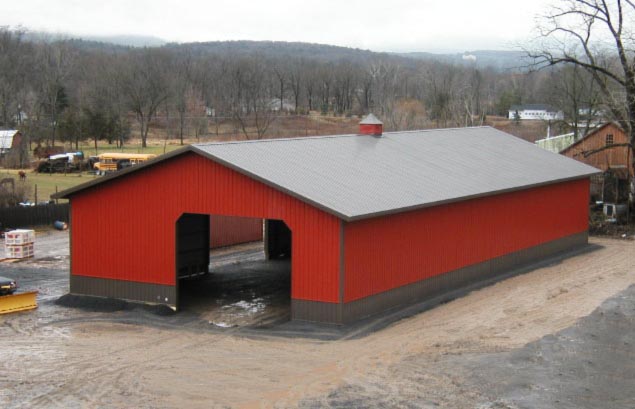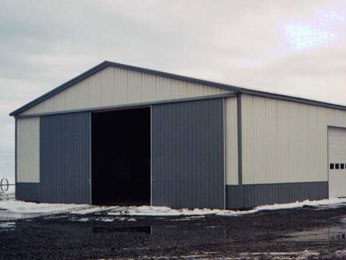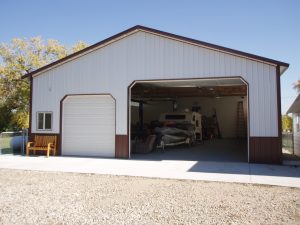Welcome to Ask the Pole Barn Guru – where you can ask questions about building topics, with answers posted on Mondays. With many questions to answer, please be patient to watch for yours to come up on a future Monday segment. If you want a quick answer, please be sure to answer with a “reply-able” email address.
Email all questions to: PoleBarnGuru@HansenPoleBuildings.com
DEAR POLE BARN GURU: I had a 40×90 pole barn built by Pekul Buildings in 2007 with the intention of being cold storage only. The 40′ trusses are 4/12 pitch and on 9′ centers. I think the trusses were made by Midwest Manufacturing, and I can see a stamp on them stating 30/4/1 rating for 9′ spacing. I found their truss drawings on the Menards website and see a note stating essentially no additional bottom chord loading is allowed.
Now I would like to convert one end section of it into a 40×36 workshop with steel liner paneling and insulate it with polystyrene sheet insulation… I know I should have anticipated this before it was constructed, but my situation changed and long story short now I need a workshop of my own…
The 1 PSF bottom chord loading concerns me as I would like to hang a metal ceiling and put polystyrene sheet insulation on top of that ceiling. What are my options? I had a thought (but it might not be a good one) of adding 5 additional trusses to support the workshop ceiling. The same trusses would have a 30/4/5 load rating if they were on 8′ centers or a 50/4/5 load rating if on 4′ centers. Maybe I could attach the additional trusses to the other side of the existing posts instead of bridging between posts or adding additional posts. Is this a realistic option or is there a better one? I prefer to maintain the clear span without adding any center posts (obstacles).
Your input is greatly appreciated, as you clearly are the pole barn guru!
Thank you, MINDFUL IN MUKWONAGO
DEAR MINDFUL: Thank you for your kind words!
Re-purposing pole buildings happens a lot, you will not be the first, nor the last to deal with issues of wanting to finish a ceiling in a building which was not designed to support one.
The first place I would start would be to contact Midwest Manufacturing and inquire about a repair which would allow for an increase in the bottom chord dead load to 5 pounds per square foot, from 1. More often than not, this is the least expensive solution.
While trying to add another truss to the opposite side of the columns, or in between the existing columns might be a solution, it is going to come with expense, lots of work to get them in place inside your building, and a fair amount of mental frustration.
Interior columns are not going to be a viable solution – your existing trusses are designed to clearspan, placing a column beneath them is going to entirely changing the load paths within the trusses and could cause a failure.
As a loyal reader, you know I am not a huge fan of steel liner panels for ceilings. https://www.hansenpolebuildings.com/blog/2013/08/steel-liner-panels/
If it works for you and meets your needs, wonderful.
For ease of installation, lowest cost and overall best performance, I would encourage you to look at blown in insulation.
No matter which path you ultimately follow, if you create a dead attic space, be sure to adequately ventilate.
https://www.hansenpolebuildings.com/blog/2014/02/pole-building-ventilation/
Mike the Pole Barn Guru
and a followup from Mindful…
DEAR POLE BARN GURU: Thank you for taking the time to reply, and so soon!
I sent an inquiry to Midwest Manufacturing and we will see how/when they reply.
I do have the ability and equipment to install additional trusses inside this building, as I do some pretty complicated and technical construction work. I also have a mechanical engineering background. Just not sure if it is the best option for supporting a ceiling.
I am not against the echo effect of steel liner panels, and do admire their lighter weight and easier cleaning. I plan on using the workshop for my automotive hobby work and occasional welding/fabricating. I also plan on heating it intermittently to prevent condensation.
I am leaning towards using polystyrene sheets for insulation as I have a good source for free surplus material up to 8″ thick. Free is good if it will work!
The building already has eave and ridge ventilation.
Condensation on the bottom of the roof tin is another issue. I was misled by the builder as they said the eave and ridge vents would prevent this. I am unsure of what can be done besides spraying insulation against that surface. I have seen roof panels rust completely through (from the bottom side up) on a metal frame building with foil faced fiberglass insulation and heat, and do not want that problem with mine.
Thank you again for the fast response. Your problem solving contributions make this world a better place. I do the same automotive-wise for others. MINDFUL IN MUKWONAGO
DEAR MINDFUL: Thank you very much again – it really is about paying it forward.
Hopefully a truss repair will be the easiest solution.
If you do decide to add trusses, they should be directly attached to the existing ones – not on the opposite side of the column. None of the existing trusses is designed to be able to support a ceiling load, so the new ones would need to do all of the ceiling load carrying work.
If you do not have a good vapor barrier under your concrete floor, heating will actually ADD to the condensation problems, as it will cause moisture to rise through your slab. If you do not have a vapor barrier under the floor, then a good sealant should be added to the top of the slab and you may need to add ventilation.
There do exist some builders who either are lazy, or just do not have the knowledge to understand what the cause of condensation is. Eave and ridge vents alone do not normally prevent condensation problems. Pretty much your choices now are going to be spray foam, or to remove the roof steel, apply reflective insulation, and reinstall the steel.
Mike the Pole Barn Guru
DEAR POLE BARN GURU: I added a pole structure 30 x 32 (ready for trusses) to an existing 40 x 30 pole barn. It is square to the back of the building but it is out of square by two and three-quarter inches from the front of the structure. (hindsight is 20/20) I should’ve run a string from the front of the building, looking for solutions other than excavating around the posts and re squaring. OH NO IN ORCHARD PARK
DEAR OH NO: Whether you do or do not have a serious challenge depends upon where the “out of square” is occurring. Pole buildings can be very forgiving and can hide a plethora of oops!
What is important is the ability to have the roof planes square, and the columns on each wall in a straight line. If those two things can occur, then the rest can be worked around.
This is where it really helps to be able to work from a building kit which has explicit written assembly instructions, including diagrams and photos. You should make sure to refer to the ones you received with your building often as you continue on your installation.
As you do not yet have the trusses placed, there is plenty of time to be able to adjust things at the eave line so the width and length measures are 30 and 32 feet from outside of column to outside of column (assuming you set your columns to approximately these measures – some people hold their columns in 1-1/2” resulting in added work and cutting).
With the width and length measures adjusted to “right on” (is necessary), square up the diagonals of the corner columns and brace them so they stay securely in place while trusses and purlins are installed. Take caution to insure the roof does not grow or shrink while placing purlins.
Prior to installing reflective roof insulation and steel over the purlins, square up each roof plane – if you have followed my advice, this should be fairly easy. With the roof now square and the columns basically in a straight line at the ground, install the balance of the wall framing.
With the “unsquareness” you originally reported, there is a good chance one of your corner columns is not going to be plumb. This will not be the end of life as you know it – just run the steel panels on the wall to plumb and the differences can be hidden behind corner trims. The worst thing is – someone who is really looking will be able to tell the corner trim does not exactly parallel the steel ribs.
Mike the Pole Barn Guru









